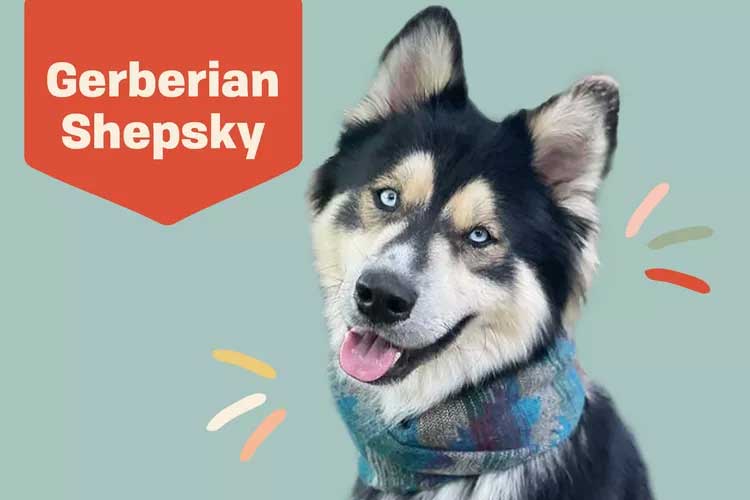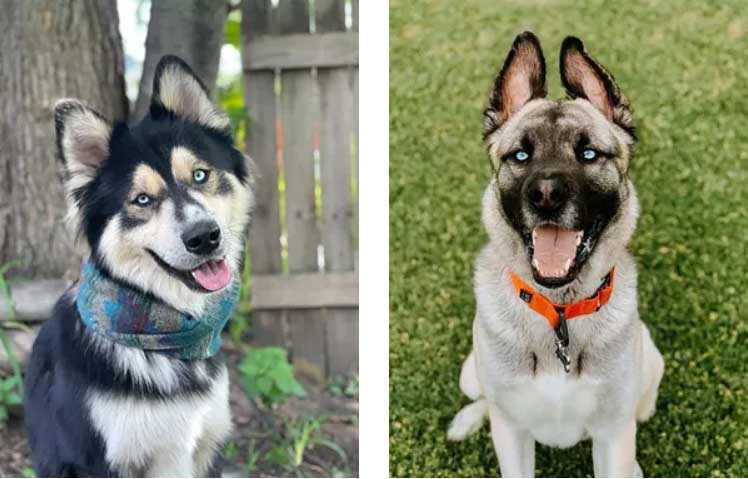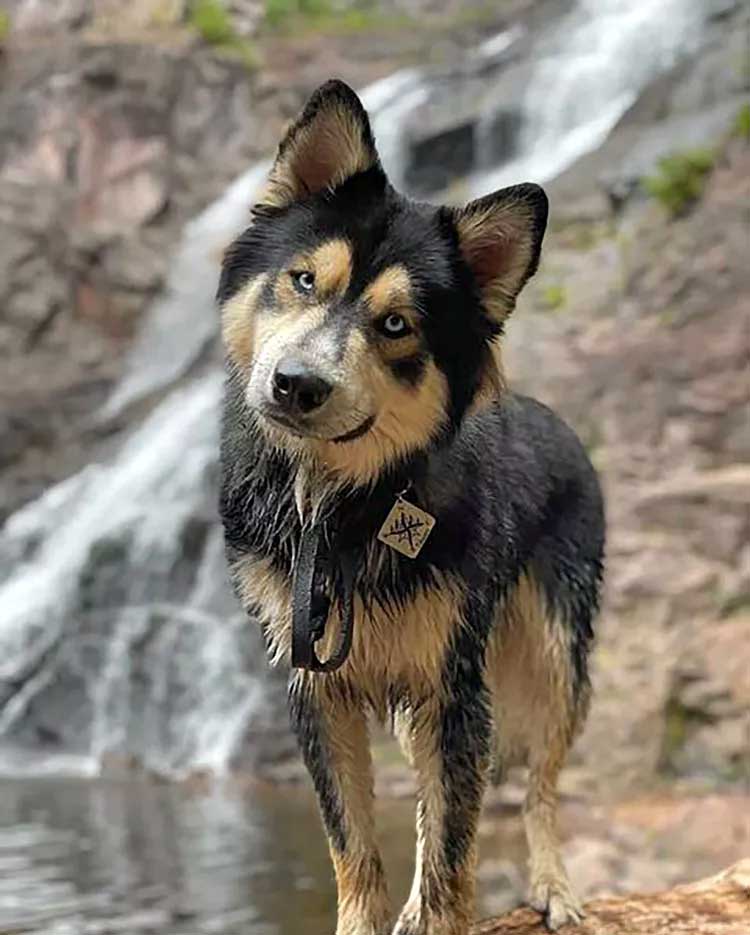A cross between a German shepherd and a Siberian husky, the Gerberian shepsky is (typically) a blue-eyed beauty with an independent nature and an exercise routine worthy of an Olympic athlete. Learn more about living with this high-energy mixed breed.

Gerberian Shepsky Overview
| OFFICIAL NAME | Gerberian Shepsky |
| COMMON NAME | Gerberian Shepsky |
| PET HEIGHT | 20 to 26 inches |
| PET WEIGHT | 45 to 60 pounds |
| LIFESPAN | 7 to 14 years |
| GOOD WITH | dogs, families |
| TEMPERAMENT | aloof, outgoing, playful, willful |
| INTELLIGENCE | high |
| SHEDDING AMOUNT | frequent |
| EXERCISE NEEDS | high |
| ENERGY LEVEL | active |
| VOCAL LEVEL | when necessary |
| DROOL AMOUNT | low |
| BREED GROUP | hybrid |
| BREED SIZE | medium (26-60 lbs.) |
| COAT LENGTH | medium |
| COLORS | black, blue, brown / chocolate / liver, gray, red, white |
| PATTERNS | bicolor, black and tan, blue and tan, liver and tan, sable, tricolor |
| OTHER TRAITS | cold weather tolerant, good hiking companion, loves water, requires lots of grooming, strong loyalty tendencies, tendency to chew |
German shepherds and Siberian huskies are two of the most popular dog breeds, so it comes as no surprise that there's a demand for a cross-breed. Dubbed the "Gerberian shepsky," this mixed breed combines the smaller stature and stunning blue eyes of a husky with the strength and intelligence of a German shepherd.
The Gerberian shepsky might be beautiful, but she's not the right dog for first-time pup parents. Pam Nichols, DVM, past president of the American Animal Hospital Association, says the breed's off-the-charts energy level and independent mind means these pups need an experienced owner who's willing to provide a lot of exercise, mental stimulation, and ongoing training.
In return for providing the right environment for an active, intelligent shepsky, you'll be rewarded with a can't-beat outdoor adventure buddy.
Appearance
One of the biggest reasons shepherds and huskies are combined is for their stunning appearance, Nichols says. This mixed breed resembles a blue-eyed German shepherd or a white German shepherd (depending on the traits the offspring inherit), driving the demand for the Gerberian shepsky.
Because the shepsky is not a true breed, there is no breed standard and, like all mixed breeds, there are no guarantees which physical traits your Gerberian shepsky puppy will inherit.
In general, these dogs tend to be medium-sized; they are often smaller than German shepherds but larger than most Siberian huskies, Nichols says. Their heights can range from 20–26 inches and they typically weigh less than 60 pounds, depending on the size of the parents.
Gerberian shepskies have double coats and medium-length hair. Their fur can be a wide combination of colors, including black and white; grey and white; red and white; black, tan and white; black; black and red; white; sable; grey; blue; or liver. Again, it all depends on the colors of their parents.
Temperament
German shepherds are known for being confident and courageous, and they're often used as working dogs in fields like law enforcement where their strength and loyalty are prized. Siberian huskies tend to be outgoing, friendly, and mischievous; a breed that was bred to "be an independent problem solver," Nichols says.
While each parent breed has distinct personalities, there is no typical Gerberian shepsky temperament.
"You don't know what you're going to get," Nichols says. "You might get a really sweet biddable dog or you might get a challenging dog that doesn't want to listen."
In general, the Gerberian shepsky tends to be highly energetic; these dogs will need lots of exercise and mental stimulation. And while they can be playful and outgoing with their family, they might be wary of strangers, Nichols says. Early socialization and consistent training is important for Gerberian shepsky puppies to learn that what's unknown isn't always scary.
Living Needs
The Gerberian shepsky requires a specific living situation to thrive: Nichols suggests homes in northern climates (hello, Minnesota, North Dakota, and Canada) with owners who are outdoor enthusiasts, super active, and have lots of experience raising dogs.Both German shepherds and Siberian huskies are working dogs with boundless energy and a near-constant need to go, go, go, so expect to spend a lot of time exercising a Gerberian shepsky. They make excellent hiking partners and will happily tag along on almost any adventure, especially when it's cold outside.

"[They] might be a good choice for an owner that wants the best hiking buddy in the world to go out and climb glaciers with in the middle of winter," Nichols says.
This is not a breed that can be let out into the backyard to entertain itself. In fact, Siberian huskies are notorious problem solvers and will look for opportunities to escape—a trait your shepsky might inherit.
"If you put a husky in your backyard, the problem they will solve is your fence," Nichols says. "They will solve it by either going over it, under it, or through it. [The fence] is a problem and it becomes their focus."
A well-socialized Gerberian shepsky can live well with other pets and children, but Nichols says they might not be the best fit for homes with small kiddos due to their boundless energy and not-so-small size.
Care
Expect grooming a Gerberian shepsky to be intense. The parent breeds are known for their medium-length double coats and shedding massive amounts of hair."No amount of at-home grooming will keep up," Nichols says. "Plan on a professional grooming every four to six weeks."
In addition to bathing and removing excess hair, groomers will perform essential tasks such as nail trimming and ear cleaning. Make appointments with your veterinarian for routine dental cleanings, too.
You can't expect a walk around the block to tire out a Gerberian shepsky. Nichols says both German shepherds and Siberian huskies are athletes—their exercise routine should include a variety of activities (think hiking, swimming, running, and biking). Depending on your shepsky's temperament, she may also excel in dog sports like tracking, obedience, agility, and rally.

Mental stimulation is essential, too. Puzzle feeders and games like hide and seek are ideal for keeping Gerberian shepsky brains active. Training is an important element of mental stimulation.
German shepherds are known for being more trainable than Siberian huskies (a breed that has a reputation for being independent thinkers), so your pup may be eager to learn new skills, or she might think it's rather boring. Still, training is essential for a happy, healthy, and stable dog. Always use positive reinforcement methods and keep training sessions short and fun to hold your pup's attention.
Health
The Gerberian shepsky is a "designer dog" that results from crossing two established breeds. Nichols believes that the breed can experience some of the same common health issues that affect the parent breeds.
This includes degenerative myelopathy, a progressive disease that targets the spinal cord and causes hind limb weakness and paralysis. It's common in German shepherds and the earliest symptoms include swaying while standing, lack of balance, and hind feet scraping the ground when walking. "They go from normal to not able to walk at all over the period of about six to 15 months," Nichols explains. She calls the disease "slow and unpredictable." There is no treatment or cure.
Another disease, pannus (also known as chronic superficial keratitis) affects the cornea and is also common in German shepherds. Pannus causes a mass to form on the cornea that spreads and triggers scarring. Steroids are often used to treat the condition, but without intervention, pannus can lead to blindness.
Hip dysplasia is another degenerative condition common in both German shepherds and Siberian huskies. It's diagnosed when the hip joint and socket don't fit quite right, leading to a painful grinding in the joint. Although there is no cure, it can often be managed with anti-inflammatory medications and physical therapy. Surgery may also be needed.
History
The German shepherd was originally bred as a herding dog and used to control large flocks of sheep in its native Germany. Over time, the speed, agility, intelligence, and authority that the breed exhibited in the field allowed the German shepherd to become a popular working dog, especially in law enforcement.In contrast, the Siberian husky got its start in Asia, where the breed was used as endurance sled dogs for the semi-nomadic Chukchi tribe. In addition to their reputations as award-winning sled dogs, Siberian huskies were (and remain) popular companion animals.
How the Gerberian Shepsky developed is anyone's guess. Nichols suspects a desire to create a so-called designer dog that was smaller in stature than the German shepherd with the blue eyes of a husky contributed to the decision to cross the breeds.
Fun Facts
Shepskies aren't the only adorable Siberian husky mixes you can find. Huskiepoos (husky and poodle mixes), Goberians (husky and golden retriever mixes) and Pomskies (husky and Pomeranian mixes) are just as fun!Siberian huskies are known for their piercing blue eyes—or eye, as the breed can have heterochromia, or two different-colored irises. It's not unusual to see Gerberian shepskies with one blue eye and one brown eye.